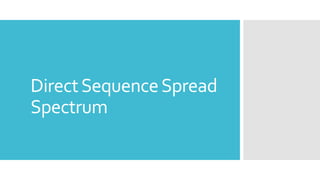Direct sequence spread spectrum
•Download as PPTX, PDF•
4 likes•306 views
Direct Sequence Spread Spectrum in Mobile Computing
Report
Share
Report
Share

Recommended
More Related Content
What's hot
What's hot (20)
Rayleigh Fading Channel In Mobile Digital Communication System

Rayleigh Fading Channel In Mobile Digital Communication System
Similar to Direct sequence spread spectrum
Similar to Direct sequence spread spectrum (20)
Direct sequence spread spectrum
- 2. Direct sequence transmission • Another spread spectrum technique . • Basic approach is to spread the narrow RF energy over a wider band in a controlled way. • Each device does the transmission over a fixed channel. • Basic high level approach is shown below: DirectSequence SpreadSpectrum
- 3. Direct sequence transmission ✔The Spreader employs an encoding scheme (Barker or Complementary Code Keying (CCK). ✔The spread signal is then modulated by a carrier. ✔The Correlator reverses this process in order to recover the original data DirectSequence SpreadSpectrum
- 4. DirectSequence SpreadSpectrum Basic steps of DSSS technique: Narrowband radio signal is processed by a spreader 1. spreader applies a mathematical transform which convert narrowband input to a flat amplitude and spread frequency band. 2. On a carrier, to a narrow band receiver it looks like a low level noise. 3.The original signal can be recovered with a correlator, which inverse of the spreading process
- 5. DirectSequence SpreadSpectrum Basic steps of DSSS technique: • Direct-sequence modulation works by applying a chipping sequence to the data stream -> original input. • Chip is a binary data used in spreading process to encode the original signal.Chipping streams are also called pseudorandom noise codes (PN codes). Advantages – -reduces frequency selective fading -in cellular networks • base stations can use the same frequency range • several base stations can detect and recover the signal
- 6. DSSS operation • Higher spreading ratios • improve the ability to recover the transmitted signal • Require a higher chipping rate and a larger frequency band. • Require more expensive RF components operating at the higher frequency DirectSequence SpreadSpectrum
